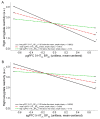Medial prefrontal cortex serotonin 1A and 2A receptor binding interacts to predict threat-related amygdala reactivity
- PMID: 22738071
- PMCID: PMC3377121
- DOI: 10.1186/2045-5380-1-2
Medial prefrontal cortex serotonin 1A and 2A receptor binding interacts to predict threat-related amygdala reactivity
Abstract
Background: The amygdala and medial prefrontal cortex (mPFC) comprise a key corticolimbic circuit that helps shape individual differences in sensitivity to threat and the related risk for psychopathology. Although serotonin (5-HT) is known to be a key modulator of this circuit, the specific receptors mediating this modulation are unclear. The colocalization of 5-HT1A and 5-HT2A receptors on mPFC glutamatergic neurons suggests that their functional interactions may mediate 5-HT effects on this circuit through top-down regulation of amygdala reactivity. Using a multimodal neuroimaging strategy in 39 healthy volunteers, we determined whether threat-related amygdala reactivity, assessed with blood oxygen level-dependent functional magnetic resonance imaging, was significantly predicted by the interaction between mPFC 5-HT1A and 5-HT2A receptor levels, assessed by positron emission tomography.
Results: 5-HT1A binding in the mPFC significantly moderated an inverse correlation between mPFC 5-HT2A binding and threat-related amygdala reactivity. Specifically, mPFC 5-HT2A binding was significantly inversely correlated with amygdala reactivity only when mPFC 5-HT1A binding was relatively low.
Conclusions: Our findings provide evidence that 5-HT1A and 5-HT2A receptors interact to shape serotonergic modulation of a functional circuit between the amygdala and mPFC. The effect of the interaction between mPFC 5-HT1A and 5-HT2A binding and amygdala reactivity is consistent with the colocalization of these receptors on glutamatergic neurons in the mPFC.
Figures





Similar articles
-
Medial prefrontal cortex 5-HT(2A) density is correlated with amygdala reactivity, response habituation, and functional coupling.Cereb Cortex. 2009 Nov;19(11):2499-507. doi: 10.1093/cercor/bhp022. Epub 2009 Mar 25. Cereb Cortex. 2009. PMID: 19321655 Free PMC article.
-
Expression of serotonin 1A and 2A receptors in molecular- and projection-defined neurons of the mouse insular cortex.Mol Brain. 2020 Jun 29;13(1):99. doi: 10.1186/s13041-020-00605-5. Mol Brain. 2020. PMID: 32594910 Free PMC article.
-
Identifying serotonergic mechanisms underlying the corticolimbic response to threat in humans.Philos Trans R Soc Lond B Biol Sci. 2013 Feb 25;368(1615):20120192. doi: 10.1098/rstb.2012.0192. Print 2013. Philos Trans R Soc Lond B Biol Sci. 2013. PMID: 23440464 Free PMC article. Review.
-
Probing the association between serotonin-1A autoreceptor binding and amygdala reactivity in healthy volunteers.Neuroimage. 2018 May 1;171:1-5. doi: 10.1016/j.neuroimage.2017.12.092. Epub 2017 Dec 29. Neuroimage. 2018. PMID: 29292133
-
Cannabidiol and the corticoraphe circuit in post-traumatic stress disorder.IBRO Neurosci Rep. 2021 Aug 21;11:88-102. doi: 10.1016/j.ibneur.2021.08.001. eCollection 2021 Dec. IBRO Neurosci Rep. 2021. PMID: 34485973 Free PMC article. Review.
Cited by
-
Strain-dependent variations in stress coping behavior are mediated by a 5-HT/GABA interaction within the prefrontal corticolimbic system.Int J Neuropsychopharmacol. 2014 Oct 31;18(3):pyu074. doi: 10.1093/ijnp/pyu074. Int J Neuropsychopharmacol. 2014. PMID: 25522413 Free PMC article.
-
Flibanserin-Stimulated Partner Grooming Reflects Brain Metabolism Changes in Female Marmosets.J Sex Med. 2015 Dec;12(12):2256-66. doi: 10.1111/jsm.13068. Epub 2015 Dec 4. J Sex Med. 2015. PMID: 26635207 Free PMC article.
-
Fluctuations in [¹¹C]SB207145 PET binding associated with change in threat-related amygdala reactivity in humans.Neuropsychopharmacology. 2015 May;40(6):1510-8. doi: 10.1038/npp.2014.339. Epub 2015 Jan 6. Neuropsychopharmacology. 2015. PMID: 25560201 Free PMC article. Clinical Trial.
-
Sex and social status modify the effects of fluoxetine on socioemotional behaviors in Syrian hamsters and rhesus macaques.Pharmacol Biochem Behav. 2022 Apr;215:173362. doi: 10.1016/j.pbb.2022.173362. Epub 2022 Feb 24. Pharmacol Biochem Behav. 2022. PMID: 35219757 Free PMC article.
-
Regulating prefrontal cortex activation: an emerging role for the 5-HT₂A serotonin receptor in the modulation of emotion-based actions?Mol Neurobiol. 2013 Dec;48(3):841-53. doi: 10.1007/s12035-013-8472-0. Epub 2013 May 22. Mol Neurobiol. 2013. PMID: 23696058 Review.
References
-
- Pezawas L, Meyer-Lindenberg A, Drabant EM, Verchinski BA, Munoz KE, Kolachana BS, Egan MF, Mattay VS, Hariri AR, Weinberger DR. 5-HTTLPR polymorphism impacts human cingulate-amygdala interactions: a genetic susceptibility mechanism for depression. Nat Neurosci. 2005;8(6):828–34. doi: 10.1038/nn1463. - DOI - PubMed
Grants and funding
LinkOut - more resources
Full Text Sources

